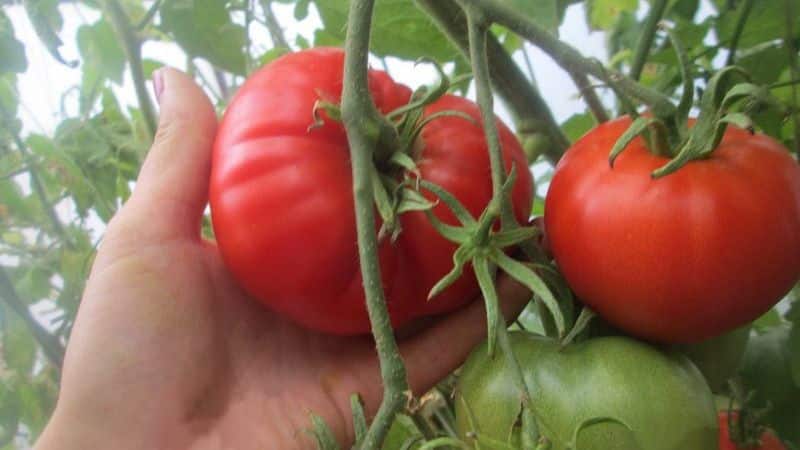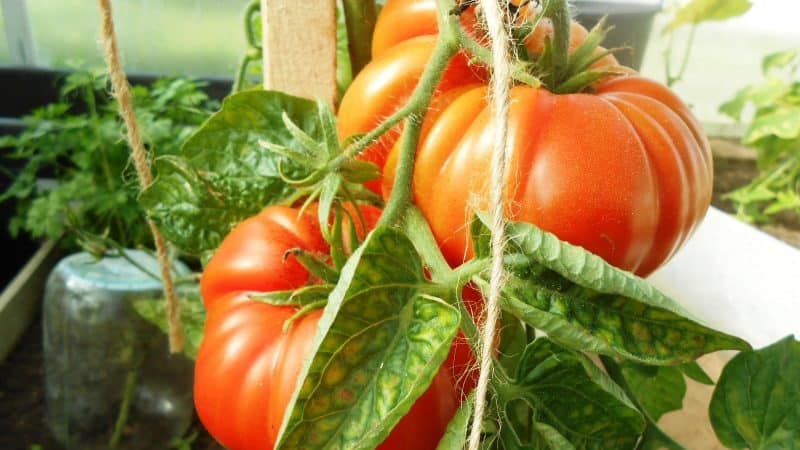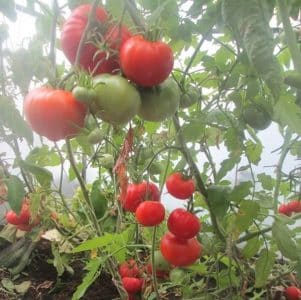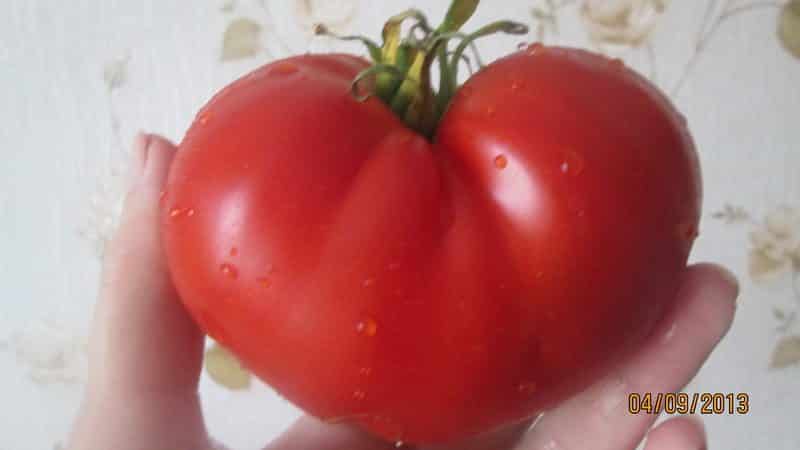We get a rich harvest even in unfavorable weather conditions by growing the “Altai Masterpiece” tomato
Thanks to the work of domestic breeders, the Altai masterpiece tomato produces a bountiful harvest and almost never gets sick. The variety is hardy, which makes it possible to grow tomatoes even in the most extreme conditions.
Description of the variety
Tomato variety Altai masterpiece – indeterminate. Bushes grow up to 2 m or more. To stop the growth of powerful plants, they pinch off the tops.
The optimal height for a tomato is 1.5 m in open ground and 1.8 m in greenhouse conditions. The stem is powerful and thick, gives a lot stepchildren. The branches are also strong and can withstand a significant load of heavy fruits. The leaves are large, light green in color.
Clusters with flowers are formed above the 10-11th leaf. The rest appear every third leaf. The inflorescences of the variety are simple. The peduncle has joints.
Distinctive features

Ripe fruits are distinguished by their uniformity and impressive size. Large tomatoes are located throughout the plant, and not just on the lower clusters, as is often the case with other varieties.
The fruits have dense pulp, tolerate transportation well and are stored for a long time. Since the crop is not a hybrid tomato, vegetable growers collect seeds from the fruits for further propagation.
A characteristic feature of the tomato is the rapid fruiting. At the beginning of August, the bushes are literally strewn with large tomatoes, which ripen in a short time.
Fruit characteristics, yield
If the rules of agricultural technology are observed, the Altai Masterpiece variety produces an abundant and high-quality harvest. Vegetables ripen 110–120 days after germination (in early to mid-August).
The bright red fruits have a rounded-flattened shape with slight ribbing. Before ripeness, tomatoes are light green, with a dark spot around the stalk, which disappears when ripe. One tomato weighs from 200 to 400 g, but some reach a weight of 500 g. In greenhouse conditions, some specimens grow to a record size of 1 kg.
Important! Large tomatoes can break off even strong branches, so a support is installed near the plants.
The pulp of the fruit is fleshy, juicy, aromatic, of medium density. The dry matter content in tomato is 5-6%. Each vegetable contains 6 seed chambers. Tomatoes taste pleasant, delicious, sweet and sour. The shell of the vegetables is dense and does not crack.
How to grow seedlings
The Altai masterpiece tomato variety is grown through seedlings. The seeds are sown at the end of February, after about 60 days the grown and hardened plants are planted in a permanent place of growth. In order for the crop to grow well and bear fruit, vegetable growers follow the rules of agricultural technology.
Seed preparation
Seed material must be fresh. The grains are purchased in a specialized store or collected independently from your own harvest.
Before sowing, the seeds are placed in a container with salt water for 5–10 minutes (10 g of salt per 1 liter of water). During this time, low-quality grains will float to the surface and are thrown away. Next, suitable seed material is rinsed in clean water and placed for 20–30 minutes in a 1% solution of potassium permanganate, then washed again and sprayed with a growth stimulant, for example, “Kornevin”, “Epin” or “Heteroauxin”.
To make the seeds hatch faster, two days before sowing they are laid out on a damp cotton cloth and covered with it. Place in a dark, cool place. The tissue with seed material is kept moist.
Container and soil
Seeds are planted in wooden boxes or special containers. You can use cut-off juice or milk cartons, but most vegetable growers grow seedlings in peat pellets or cups. To drain excess liquid, several holes are made at the bottom of the containers.
Peat products simplify the process of plant picking. The glass along with the seedlings is transplanted into large containers. The peat gradually becomes limp and dissolves in the soil, and young plants are not damaged or stressed.
To grow strong seedlings, use high-quality soil:
- most vegetable growers buy ready-made soil mixture for seedlings;
- some prepare the soil themselves by mixing garden soil, humus, sand (sawdust) and wood ash in a ratio of 2:1:1:1.
Before use, the finished soil is disinfected - poured generously with boiling water or a 1% solution of potassium permanganate. This will destroy harmful bacteria and pest larvae.
Sowing
Seeds are sown in furrows according to a 3x5 cm pattern. If disposable cups are used, no more than 1-2 grains are planted in one container. The seeds are embedded in the soil to a depth of 1–1.5 cm, sprinkled with a thin layer of earth and sand mixed in equal parts.
In order not to wash away the soil, the soil is carefully sprayed with a sprayer. For humidification, use settled water at room temperature. Next, the container with the seeds is covered with film or transparent glass and placed in a warm, bright place.
Growing and care
When the first shoots appear, the cover is removed and the container is placed on the windowsill on the south side of the house. In order not to injure young shoots, the air temperature and humidity are maintained at the same level.
When the plants grow 3-4 true leaves, they begin to harden the seedlings. Two weeks before transplanting to a permanent place, take it outside or onto a balcony for 2 hours. The time the plants spend in the fresh air is gradually increased. This procedure is carried out so that young plants do not get sick and quickly get used to new conditions.
How to grow tomatoes

When the seedlings reach the age of 50–60 days, the crop is transplanted to a permanent place. The variety is resistant to low temperatures, so the plants thrive in open ground, where they bear fruit until frost.
Landing
For better development and yield of the crop, fertilizers are placed at the bottom of the holes before planting.
For this you will need:
- a shovel of peat or sand;
- 1 kg of rotted manure;
- 0.5 liters of wood ash.
With this planting, the Altai masterpiece tomato is quickly accepted and restores damaged roots in a short time.
Care
Fertilizers are applied not only before planting in the holes, but throughout the entire growing season. The first feeding is carried out two weeks after planting the seedlings in a permanent place. Then they fertilize when the plants are flowering and again at the height of fruit ripening.
The Altai masterpiece tomato variety needs minerals for the formation of ovaries. Without fertilizers, the crop becomes weak and sick, and the ovaries fall off in the first stages of development.
The fruits of the variety do not crack, and the plant itself has good resistance to late blight, so tomatoes are watered abundantly, but rarely.This option is suitable for summer residents who come to their plots only on weekends.
The bushes are moistened at the root in the morning or evening hours, when the sun is not scorching. After watering, the soil is loosened and weeds are removed at the same time.
Features of cultivation and possible difficulties
Growing Altai masterpiece tomatoes is no different from cultivating other varieties. To obtain high yields, plants are fertilized in a timely manner. It is necessary to tie the branches to the supports in a timely manner to prevent them from breaking off.
Diseases and pests
The Altai masterpiece tomato practically does not get sick and grows well even in the rainiest summer. The variety is resistant to late blight, Alternaria, root and fruit rot, which greatly facilitates the cultivation of tomatoes in open ground.
Although the variety is not susceptible to diseases, vegetable growers still adhere to some rules for preventive purposes:
- remove remnants of vegetation from the beds;
- weed the soil around the plants and get rid of weeds;
- follow the rules of crop rotation.
On a note. When growing tomatoes in greenhouse conditions, the room is regularly ventilated.
The resistance of the variety against tomato diseases allows it to be successfully cultivated in open ground. The main thing is to protect plants from pests.
The Colorado potato beetle is gotten rid of by treating with chemicals, for example, “Bankol”, “Karate” or “Killer”. Caterpillars, slugs and other crawling pests of bushes are repelled with wood ash or copper sulfate.
The nuances of growing in open ground and in a greenhouse
 Tomato bushes must be pinched and tied to a support. If necessary, pinch the plants so that 4-5 leaves remain above the topmost inflorescence.
Tomato bushes must be pinched and tied to a support. If necessary, pinch the plants so that 4-5 leaves remain above the topmost inflorescence.
Some gardeners leave one main stem, but the crop grows well if the plants are formed into two or even three stems. For the second shoot, a stepson is left, which grows under the first brush.
To ensure that the tomatoes get more sunlight and air, the leaves on the bushes below the first cluster are removed. To obtain larger fruits, gardeners get rid of small or ugly flowers on the racemes.
The Altai masterpiece variety bears fruit on almost any soil, but for this purpose the rules of crop rotation are followed.
Good predecessors for tomatoes:
Tomatoes are not grown after potatoes, tomatoes and other nightshades earlier than 3-4 years. This is due to the fact that the soil becomes a potential carrier of infections and pest larvae.
For your information. Thanks to its hardiness and cold resistance, this tomato variety produces a bountiful harvest in open ground, but in a greenhouse the yield is much higher.
Harvesting and application
The first fruits ripen four months after seed germination - in early August. Fruiting lasts until the first days of October. Vegetables are carefully collected and placed in boxes. This will preserve the fruits during long-term transportation or long-term storage.
Tomatoes are used for fresh salads, but with a large harvest in the incomplete ripeness phase, they are used to prepare various canned preparations. Delicious juices or sauces are made from fully ripe vegetables, rich in thick pulp.
Advantages and disadvantages of the variety

Advantages of the Altai masterpiece tomato:
- strong immunity to diseases and pests;
- high productivity;
- good transportability due to dense structure;
- versatility in application;
- excellent taste;
- good presentation;
- plant resistance to drought and waterlogging;
- the ability to collect seeds from your own harvest;
- resistance to low temperatures;
- long fruiting period.
The variety does not have many disadvantages:
- the plant needs pinching;
- the bush must be tied to a support;
- a tall tomato requires a spacious greenhouse;
- impossibility of preserving large fruits.
Farmer reviews
The Altai masterpiece tomato is gaining more and more popularity among vegetable growers. Summer residents prefer this variety for its impressive list of positive characteristics. Here are just some of the opinions of gardeners.
Svetlana, Rostov: “I’ve been growing tomatoes for about 10 years. One of my favorite tomato varieties is Altai masterpiece. The bushes grow to the ceiling of the greenhouse. Culture does not require much attention. During the entire growing season, the plants never got sick, but I carried out preventive measures against insects several times. There was a lot of harvest. One tomato weighs on average 300–400 g. The fruits are beautiful, as in the photo, and most importantly, tasty.”
Sergey, Odintsovo: “The Altai masterpiece tomato variety was grown through seedlings, then transplanted into a greenhouse. The first fruits appeared at the end of July. There were a lot of vegetables, I didn’t know what to do with them. I gave some of it to the children, and from the rest I made tomato juice for the winter. The whole family liked the variety. Next year I will plant the Altai Masterpiece tomato again.”
Conclusion
The Altai Masterpiece variety has many positive qualities. This culture has strong immunity to disease and grows well in extreme conditions.Most summer residents collect seeds from their own harvest to plant vegetables. The fruits have excellent taste and dense structure, tolerate transportation well and are stored for a long time.
Additional information about the Altai Masterpiece tomato variety can be found in the following video: